AUSTRALIA
Locals take charge of NSW floods helicopter food and rescue efforts amid frustration with ADF*
Volunteers are spending hours flying over submerged power lines and the stench of decaying cattle, delivering urgent aid to their towns
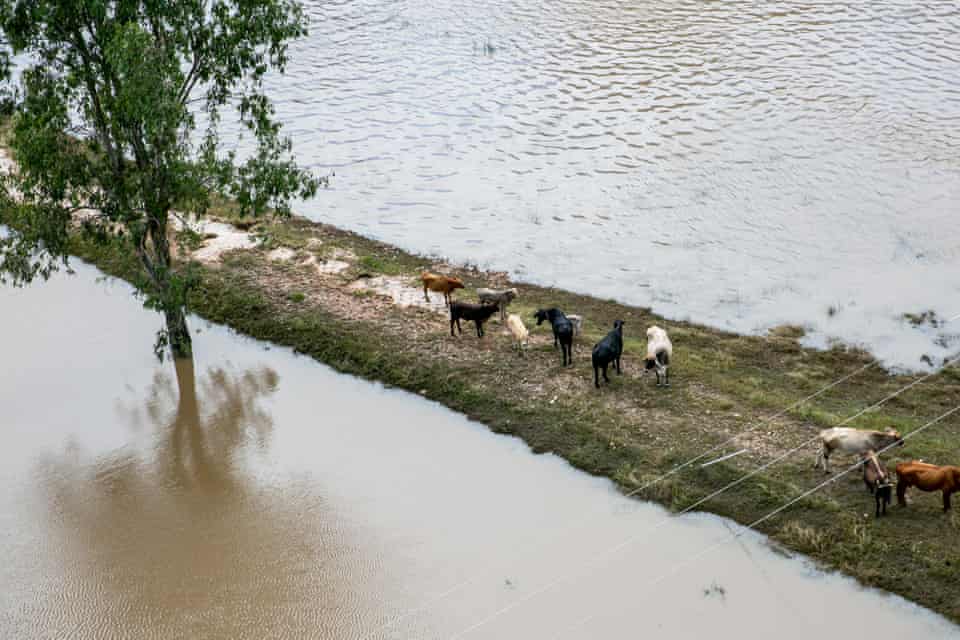
Cows are seen stuck on a small land island created by the NSW floods in the Lismore region
Volunteers are spending hours flying over submerged power lines and the stench of decaying cattle, delivering urgent aid to their towns

Cows are seen stuck on a small land island created by the NSW floods in the Lismore region
Photograph: Yaya Stempler/The Guardian
*AUSTRALIAN DEFENCE FORCE
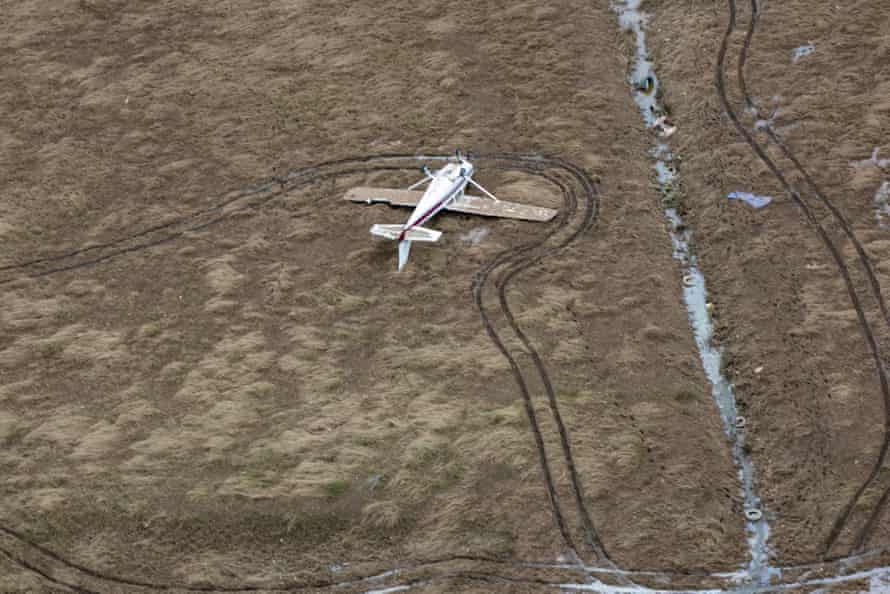 Many people requiring rescue thought they could last on their own in their properties until flood waters receded, Jess Barnes says. Photograph: Yaya Stempler/The Guardian
Many people requiring rescue thought they could last on their own in their properties until flood waters receded, Jess Barnes says. Photograph: Yaya Stempler/The Guardian
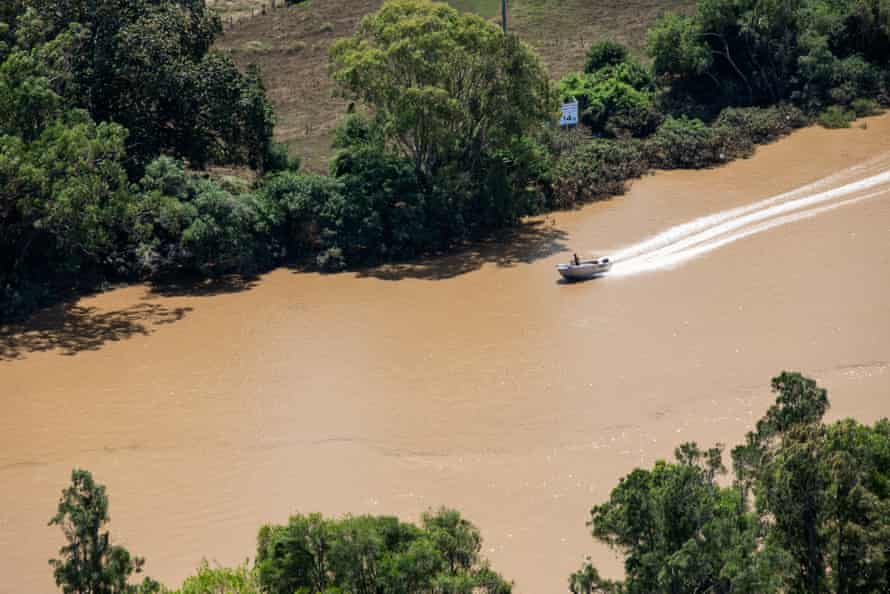
She explains that many of the people requiring rescue now thought they could last on their own in their properties until flood waters receded. The waters have proved stubborn. “They’re now realising the waters could last and they’re running out of supplies and are still totally cut off from roads.”
She is also furious, observing the radar remotely and seeing how the region is having to rely on community volunteering.
“We’re not making any money out of this, we’re the ones who started and said let’s just get as much stuff as we can to the people we hear are still out there. We didn’t even think about the money when we started.
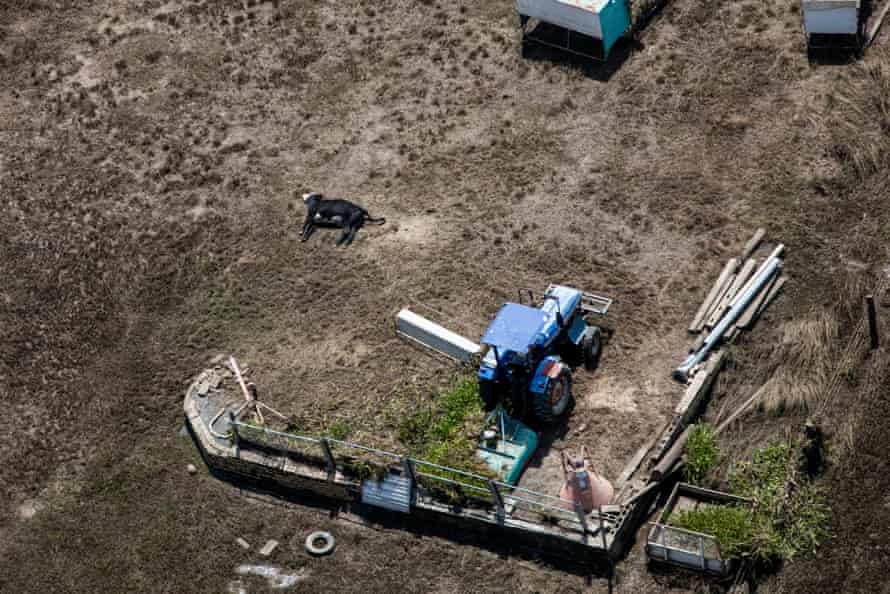
by Elias Visontay Photography: Yaya Stempler
Mon 7 Mar 2022 00.21 GM
“I’ve still got people on roofs needing food and rescuing, and I’ve just got to find someone to get to them,” says Ash Jones at the Rotorwing Helicopter hangar at the Lismore airport in northern New South Wales.
Jones has been working long hours as a volunteer air traffic controller and donation coordinator, and is de facto leader at the hangar. She says she is too busy to be interviewed.
A week after fatal floods hit Lismore and NSW’s northern rivers, the region is still in emergency mode, and with waters slow to recede and some areas still cut off, residents living in remote properties are now requiring urgent evacuations and supply drops.
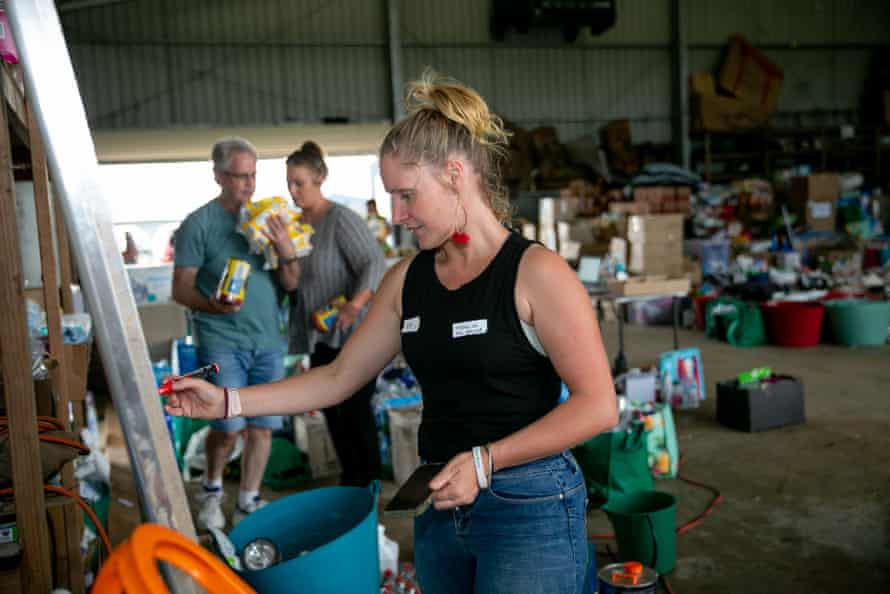 Ash Jones has been working long hours as a volunteer air traffic controller and donation coordinator. Photograph: Yaya Stempler/The Guardian
Ash Jones has been working long hours as a volunteer air traffic controller and donation coordinator. Photograph: Yaya Stempler/The Guardian
The volunteer operation sprang up out of the Rotorwing hangar last Monday, just as owner Michael Barnes’s home became flooded.
“When everyone was confused about what to do at the beginning of last week, it was the locals that started doing food drops. We set up a makeshift job card system and they’d come in and take one or two and off they’d go,” Barnes said.
Since then, a community-led emergency response unit – similar to volunteer operations in nearby Mullumbimby – has coordinated at least 200 rescue and airdrop missions delivering food, medicines and petrol to about 5,000 people living in cut-off homes over a mammoth area of north-east NSW.
Advertisement
More than 20 tonnes of essential goods have so far been delivered by a fleet of privately owned helicopters – hired thanks to a crowdfunding campaign and funds from Mick Fanning, Chris Hemsworth and the Essential Energy state-owned corporation, among others.

Mon 7 Mar 2022 00.21 GM
“I’ve still got people on roofs needing food and rescuing, and I’ve just got to find someone to get to them,” says Ash Jones at the Rotorwing Helicopter hangar at the Lismore airport in northern New South Wales.
Jones has been working long hours as a volunteer air traffic controller and donation coordinator, and is de facto leader at the hangar. She says she is too busy to be interviewed.
A week after fatal floods hit Lismore and NSW’s northern rivers, the region is still in emergency mode, and with waters slow to recede and some areas still cut off, residents living in remote properties are now requiring urgent evacuations and supply drops.
 Ash Jones has been working long hours as a volunteer air traffic controller and donation coordinator. Photograph: Yaya Stempler/The Guardian
Ash Jones has been working long hours as a volunteer air traffic controller and donation coordinator. Photograph: Yaya Stempler/The GuardianThe volunteer operation sprang up out of the Rotorwing hangar last Monday, just as owner Michael Barnes’s home became flooded.
“When everyone was confused about what to do at the beginning of last week, it was the locals that started doing food drops. We set up a makeshift job card system and they’d come in and take one or two and off they’d go,” Barnes said.
Since then, a community-led emergency response unit – similar to volunteer operations in nearby Mullumbimby – has coordinated at least 200 rescue and airdrop missions delivering food, medicines and petrol to about 5,000 people living in cut-off homes over a mammoth area of north-east NSW.
Advertisement
More than 20 tonnes of essential goods have so far been delivered by a fleet of privately owned helicopters – hired thanks to a crowdfunding campaign and funds from Mick Fanning, Chris Hemsworth and the Essential Energy state-owned corporation, among others.

The military’s slow rollout has frustrated people in the northern rivers, where unpaid and sometimes untrained volunteers fill the gaps. Photograph: Yaya Stempler/The Guardian
Local helicopter pilots have been volunteering their time, and their presence in the skies across the flood-affected region is dwarfing the official Australian defence force contingent.
By Sunday, the 14 community-organised helicopters, and a handful of other private aircraft, were averaging seven hours in the air each day running drops and performing rescues to towns such as Coraki, Bungawalbin and New Italy.
Advertisement
Meanwhile, radar showed the ADF had just two helicopters in the air, and private helicopters contracted by government agencies for flood recovery that were parked in nearby Casino were averaging just one hour in the air each day.
The ADF’s slow rollout has frustrated locals in the northern rivers who see many of their unpaid – and some untrained neighbours – filling the gaps in the impossibly large task of flood recovery across the area.
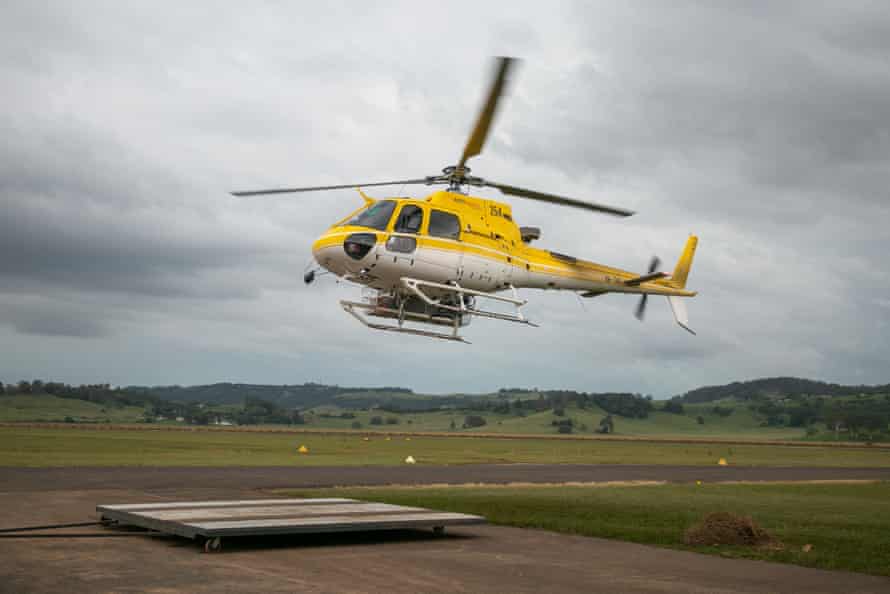
Local helicopter pilots have been volunteering their time, and their presence in the skies across the flood-affected region is dwarfing the official Australian defence force contingent.
By Sunday, the 14 community-organised helicopters, and a handful of other private aircraft, were averaging seven hours in the air each day running drops and performing rescues to towns such as Coraki, Bungawalbin and New Italy.
Advertisement
Meanwhile, radar showed the ADF had just two helicopters in the air, and private helicopters contracted by government agencies for flood recovery that were parked in nearby Casino were averaging just one hour in the air each day.
The ADF’s slow rollout has frustrated locals in the northern rivers who see many of their unpaid – and some untrained neighbours – filling the gaps in the impossibly large task of flood recovery across the area.

A helicopter getting ready to assess the damage caused by the floods in Lismore. Photograph: Yaya Stempler/The Guardian
On Sunday, Roger Mohr of V2 Helicopters was one of the volunteer pilots flying west from Lismore performing emergency food drops.
Even on the ground, the smell left behind by the floods is still unpleasant. The sun has been beating down on the stagnant muddy water, sewage and rotting cows, with high humidity and apparent temperatures at 35C.
Flying over the vast ocean of brown that the northern rivers region now resembles, the rising stench flows through Mohr’s aircraft as he passes above submerged power lines, abandoned cars and detached airplane wings strewn across fields.
“The dead cattle is particularly unpleasant, it’s such a distinct smell,” he said. While many of the cows he flies over are already dead, some are alive but emaciated, stuck on small land islands with no food. He records their location, to alert the community effort at the hangar, as they are also organising feed drops for stranded cattle.
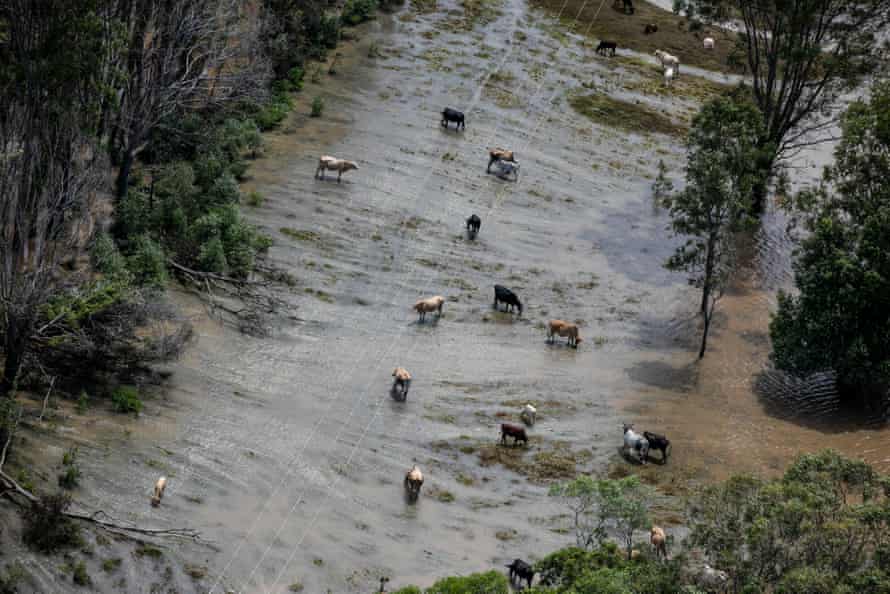
On Sunday, Roger Mohr of V2 Helicopters was one of the volunteer pilots flying west from Lismore performing emergency food drops.
Even on the ground, the smell left behind by the floods is still unpleasant. The sun has been beating down on the stagnant muddy water, sewage and rotting cows, with high humidity and apparent temperatures at 35C.
Flying over the vast ocean of brown that the northern rivers region now resembles, the rising stench flows through Mohr’s aircraft as he passes above submerged power lines, abandoned cars and detached airplane wings strewn across fields.
“The dead cattle is particularly unpleasant, it’s such a distinct smell,” he said. While many of the cows he flies over are already dead, some are alive but emaciated, stuck on small land islands with no food. He records their location, to alert the community effort at the hangar, as they are also organising feed drops for stranded cattle.

While many of the cows Roger Mohr flies over are already dead, some are alive but emaciated, stuck on small land islands with no food.
Photograph: Yaya Stempler/The Guardian
While performing an airdrop on Saturday, Mohr and a co-pilot became stranded on a rural property that has been transformed into an island by the floods. They spent the night there, and continued flying drop missions on Sunday, including to cut-off Bungawalbin.
“There’s just so many civilian choppers up here, it’s a shame I haven’t come across the ADF up here,” he said while in the air.
At his hangar, Barnes is also frustrated at the slow and comparatively smaller ADF rollout.
“We don’t know where they are, have you seen them?” he said.
Barnes’s wife, Jess, evacuated with their children to family in Melbourne, and has been helping coordinate the community helicopter effort from there.
While performing an airdrop on Saturday, Mohr and a co-pilot became stranded on a rural property that has been transformed into an island by the floods. They spent the night there, and continued flying drop missions on Sunday, including to cut-off Bungawalbin.
“There’s just so many civilian choppers up here, it’s a shame I haven’t come across the ADF up here,” he said while in the air.
At his hangar, Barnes is also frustrated at the slow and comparatively smaller ADF rollout.
“We don’t know where they are, have you seen them?” he said.
Barnes’s wife, Jess, evacuated with their children to family in Melbourne, and has been helping coordinate the community helicopter effort from there.
 Many people requiring rescue thought they could last on their own in their properties until flood waters receded, Jess Barnes says. Photograph: Yaya Stempler/The Guardian
Many people requiring rescue thought they could last on their own in their properties until flood waters receded, Jess Barnes says. Photograph: Yaya Stempler/The Guardian
She explains that many of the people requiring rescue now thought they could last on their own in their properties until flood waters receded. The waters have proved stubborn. “They’re now realising the waters could last and they’re running out of supplies and are still totally cut off from roads.”
She is also furious, observing the radar remotely and seeing how the region is having to rely on community volunteering.
“We’re not making any money out of this, we’re the ones who started and said let’s just get as much stuff as we can to the people we hear are still out there. We didn’t even think about the money when we started.

A week after fatal floods hit Lismore and the NSW northern rivers, the region is still in emergency mode.
Photograph: Yaya Stempler/The Guardian
“I cannot figure out why the ADF and SES [the volunteer-led state emergency service] aren’t out there searching for people. It drives me absolutely mental that they aren’t out there searching, because I am getting messages from mothers with their babies needing rescue who haven’t heard from an agency since the floods.”
Barnes has also heard reports of the ADF coming to the hangar and around Lismore “for photo ops”. “They made it look like they were doing something and left right after taking a photo.”
In addition to air drops, civilians were also still delivering supplies and performing rescues by boat at the weekend.
For its part, an ADF spokesman denied the claim that the ADF was not present in Lismore, both on ground and in the air. He said there were 436 ADF personnel in the region as of Monday morning. He confirmed that there had been just two ADF helicopters performing drops, but said on some days in the past week this had surged to four.
Back at the hangar, just before torrential rain broke through the hot Lismore day on Sunday afternoon, Jones was weaving through the piles of donations and boxes that were beginning to feel like supermarket aisles, consulting others about whether they could perform a rescue that had been requested.
“Can we get here?” she asks, as she plans another mission.
“I cannot figure out why the ADF and SES [the volunteer-led state emergency service] aren’t out there searching for people. It drives me absolutely mental that they aren’t out there searching, because I am getting messages from mothers with their babies needing rescue who haven’t heard from an agency since the floods.”
Barnes has also heard reports of the ADF coming to the hangar and around Lismore “for photo ops”. “They made it look like they were doing something and left right after taking a photo.”
In addition to air drops, civilians were also still delivering supplies and performing rescues by boat at the weekend.
For its part, an ADF spokesman denied the claim that the ADF was not present in Lismore, both on ground and in the air. He said there were 436 ADF personnel in the region as of Monday morning. He confirmed that there had been just two ADF helicopters performing drops, but said on some days in the past week this had surged to four.
Back at the hangar, just before torrential rain broke through the hot Lismore day on Sunday afternoon, Jones was weaving through the piles of donations and boxes that were beginning to feel like supermarket aisles, consulting others about whether they could perform a rescue that had been requested.
“Can we get here?” she asks, as she plans another mission.
No comments:
Post a Comment